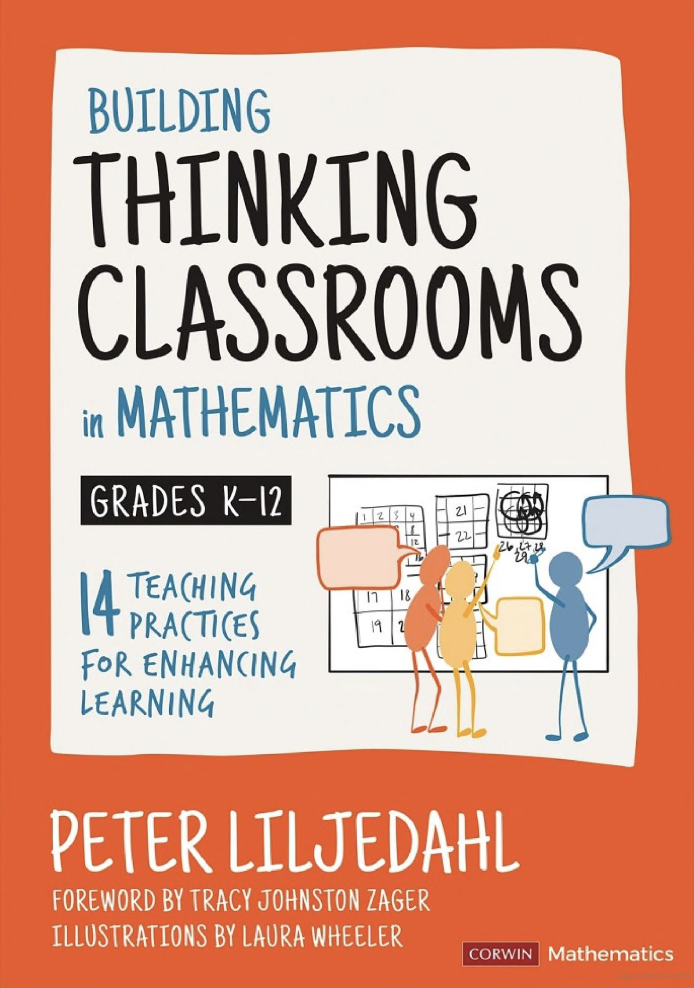Transform Teaching: Practical Strategies from the book ‘Thinking Classrooms’ by Peter Liljedahl

“Building Thinking Classrooms in Mathematics” by Peter Liljedahl delves into the shortcomings of conventional math teaching methods.
Liljedahl found that traditional methods often lead students to disengage from the thinking process.
His research offers insights into transforming these traditional practices thus promoting active student participation, greater problem-solving and critical thinking.
Although Liljedahl’s primary focus is on teaching practices within Mathematics, the strategies he uncovered hold relevance across all subjects, spanning from elementary to secondary education. These approaches advocate for students to assume responsibility for their learning and shift their focus towards active thinking rather than memorizing and regurgitating information.
What are some of the problems with traditional teaching practices?
Through his research, Liljedahl visited numerous schools and found a common trend: despite their good intentions, teachers frequently engage students in activities that require little thinking.
One commonly observed practice involves the teacher demonstrating a concept first, followed by students attempting it themselves. Through these “now-you-try” activities, Liljedahl discovered that only 20% of students effectively absorbed the demonstration and could independently replicate the strategy. Conversely, many students resorted to unproductive behaviours, including stalling, feigning task engagement, copying others’ work, or engaging in time-wasting activities like sharpening pencils or walking around the room. Only a minority genuinely attempted the strategy on their own.
So, how can students be fully engaged in lessons and encouraged to think?
Through various experiments and iterations, Liljedahl found several core strategies for transforming traditional classrooms into dynamic learning environments. While these were specific to mathematics lessons, I have found them effective in other subjects. These strategies can be applied to various tasks, increasing student engagement and critical thinking.
Strategies to create a ‘thinking’ classroom
Random Groupings
Collaboration is widely recognized as a crucial aspect of effective problem-solving. However, forming groups often proves challenging. When teachers assign groups, student disengagement is prevalent. This occurs partly because students prefer to collaborate with friends but also due to preconceived notions about their roles within the group. For example, some students may perceive certain peers as more intelligent, assuming the teacher placed them together for this reason, leading to a sense of redundancy in their contributions. Others may naturally take on leadership roles, assuming it’s the teacher’s intent based on past experiences.
Random groupings were found to be the most effective solution. It’s crucial that students perceive these groupings as genuinely random. Selecting groups in front of students significantly impact their engagement levels. Students were more willing to collaborate with a diverse range of peers when they understood that these groupings would only last for the duration of the lesson before changing again. Additionally, the random groupings challenged their preconceived notions of their roles within the group and encouraged students to take risks and participate more fully.
Furthermore, research indicates that the optimal group size for students in Grade 3 and above tends to be three members. This size allows for sufficient diversity of perspectives and minimizes the likelihood of subgroups forming within the larger group.
Vertical Non-Permanent Surfaces (VNPS)
An intriguing discovery emerged regarding using non-permanent surfaces like whiteboards or chalkboards for collaborative problem-solving. The erasability feature significantly influenced students’ willingness to take risks and be creative. With the option to erase ideas and start anew, students felt less constrained by fear of making mistakes. Consequently, they generated better ideas and experienced greater success in problem-solving overall.
Moreover, vertical whiteboards offer an additional advantage. They enable teachers to readily observe the progress of student groups and identify which groups may require support.
Encouraging autonomy
In a traditional classroom setup, teachers typically hold the majority of control, with desks arranged facing the teacher, who stands at the whiteboard. The more control the teacher exerts over the lesson, the less autonomy students experience.
While it’s not suggested that teachers should completely relinquish control, Liljedahl found that it’s essential to recognize that a lack of autonomy ultimately diminishes student engagement and active thinking.
Encouraging students to take on greater independence and responsibility for their learning yields significant benefits. One effective method is facilitating student discussions and encouraging groups to share and explain their thought processes. In addition to learning from each other, it encourages students to articulate their thoughts clearly.
Designing tasks that encourage thinking
A central principle of this book emphasizes that for students to engage in thinking, they must be presented with tasks that facilitate such cognitive processes. Problem-solving is inherently non-linear and messy; students inevitably encounter obstacles and become stuck.
However, through this process of grappling with challenges, thinking, and eventually finding solutions, they develop new understandings and insights.
Crafting an effective problem-solving task involves prompting students to face challenges that demand they wrestle with difficulty, experiment, try, fail, and creatively apply their knowledge to discover solutions.
Liljedahl outlines three essential steps for crafting rich and effective problem-solving tasks:
- Activate Prior Knowledge: Start by posing a question that taps into students’ existing knowledge. This prompts them to retrieve what they already know and prepare it for application in the problem at hand.
- Extend Prior Knowledge: Follow up with a question that builds upon their existing knowledge, requiring students to logically progress to the next step based on what they already understand.
- Encourage Trial and Error: Finally, challenge students to take action without providing explicit instructions. This prompts them to engage in a trial-and-error process, fostering experimentation and discovery.
This general formula creates tasks that encourage students to think rather than learn and then regurgitate a strategy or skill.
When tasks are given
While it may appear evident that time should be dedicated to planning lessons and designing tasks, there is often a lack of consideration regarding when or how these tasks are presented to students.
The timing and manner in which tasks are presented to students profoundly impacted their level of engagement. Through his research, Liljedahl unveiled that the timing of task distribution—whether at the middle, end, or beginning of a lesson—produced diverse outcomes.
Research indicates that when the initial phase of a lesson involves the passive reception of information, it tends to induce a low-energy state among students. It then becomes much more challenging to raise the energy levels required to encourage active thinking and effective problem-solving.
So, in observations, it was noticed that when tasks were introduced at the beginning of the lesson, students approached them with greater self-reliance and enthusiasm compared to when introduced in the middle or toward the end.
Liljedahl identified the optimal timing for task introduction to be within 3 to 5 minutes of the teacher starting to speak. This timeframe effectively prevents student energy depletion and mitigates the tendency for teachers to pre-teach the task.
How tasks are given
In addition to the timing of task delivery, how tasks are presented also significantly impacts student engagement. For instance, having students seated at their desks fosters a low-energy, passive environment.
Conversely, depending on the age of the students, allowing them to stand loosely around the teacher creates a higher-energy atmosphere.
Furthermore, it was observed that presenting questions or problems in the form of a worksheet often led students to engage in less critical thinking, as it conveyed the impression that the task was merely about completing a task rather than engaging in thinking.
When observing classrooms, tasks were typically delivered in one of three ways: either the question or problem was projected, written on a whiteboard, or distributed as a handout.
Among these three options, it was determined that projecting the task while providing verbal instructions proved to be the most effective method for engaging students.
Notetaking in lessons
Note-taking emerged as another crucial aspect in fostering a thinking classroom environment. Liljedahl identified a common practice, “I write, you write” notes, prevalent across the classrooms he observed. In this approach, teachers write notes on the board while students copy them verbatim.
It was determined that these note-taking strategies proved ineffective. One major issue with this approach was that students frequently ceased active listening in order to hurriedly transcribe all the notes. They found themselves in a dilemma where they had to choose between listening to the information being presented or copying down the notes, as attempting to do both simultaneously became unmanageable. Consequently, many students opted to either forgo listening in favor of completing their notes or abandon note-taking to focus on listening.
While live note-taking may be perceived as a more significant concern for older students, the effectiveness of note-taking, in general, has been recognized as an issue for both elementary and secondary students.
When students are instructed to take notes by simply copying information from the board, the notes are often of little use and rarely revisited. Students engage in this practice out of necessity rather than because the notes hold genuine value.
However, Liljedahl discovered that for note-taking to be effective, students need to record things they find interesting or important, as well as information they believe they won’t easily find elsewhere, such as in a textbook. This approach ensures that notes serve a meaningful purpose and are more likely to be referenced later on.
He discovered an effective strategy for promoting critical thinking during note-taking sessions. Students were prompted to consider: “What will you write down now to ensure you remember today’s lesson in three weeks?” They were allotted 10 minutes for this activity and were given the freedom to take notes in any format they preferred, such as sketch notes or diagrams. Additionally, they were encouraged to include worked examples in their notes.
Graphic organizers were also employed to foster this type of note-taking. Initially, using graphic organizers with limited space prompted students to distil the most crucial ideas from their lessons. When students had the freedom to select the information they wished to record, it not only enhanced the significance of their notes but also personalized their learning experience by focusing on what they deemed essential. This personalized approach enabled them to refer back to their notes when needed, enhancing retention and understanding.
“Building Thinking Classrooms in Mathematics” by Peter Liljedahl is an invaluable resource for reevaluating traditional teaching methods and exploring transformative approaches to foster student thinking. The strategies outlined in the book are well-structured and accompanied by practical solutions, facilitating easy implementation in the classroom. These strategies are adaptable to various lessons, making the book an essential tool for teachers seeking to enhance student engagement and critical thinking across all subjects.
Key Takeaways
- Liljedahl visited numerous schools and found a common trend: despite their good intentions, teachers frequently engage students in activities that require little thinking
- Random groupings of three students were found to be the most effective.
- Vertical Non-Permanent Surfaces (VNPS encouraged students to take risks and be creative
- facilitating student discussions and encouraging groups to share and explain their thought processes. In addition to learning from each other
- Liljedahl outlines three essential steps for crafting rich and effective problem-solving tasks: Activate prior knowledge, extend prior knowledge, and provide a new task without telling students how to complete it
- The task should be introduced 3 to 5 minutes from the teacher starting to speak
- For note-taking to be effective, students need to record things they find interesting or important, as well as information they believe they won’t easily find elsewhere, such as in a textbook
- An effective strategy for promoting thinking during note-taking is asking: “What will you write down now to ensure you remember today’s lesson in three weeks?
